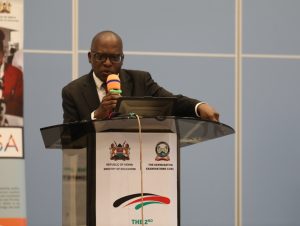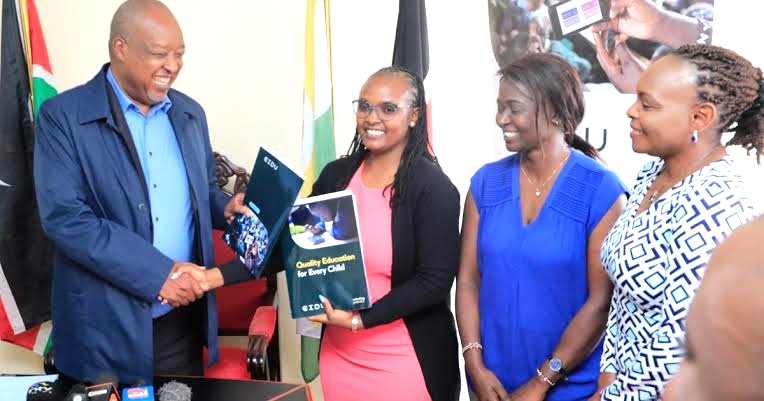The Ministry of Education (MoE) has announced the criteria that will guide the placement of Grade 10 learners under the Competency-Based Curriculum (CBC).
Senior school, which covers Grades 10 to 12, will officially begin in January 2026, marking the transition for the pioneer Grade 9 cohort.
Speaking on Wednesday, the MoE deputy director, Fred Odhiambo said there will be four categorizations of senior schools, which include pathways, accommodation, gender and special needs.

The pathways are divided into two; double representing Science Technology Engineering, Mathematics and Arts& Sports Science -STEAMS) on one hand and triple pathways senior school which involves STEM, Arts & Sports and Social Sciences.
For the accommodation category, it will consist of day senior schools for those who commute home daily and hybrid senior schools for learners who both reside in the school and not.
According to the guidelines, there will be two divisions in gender, consisting of Single Sex (girls-only schools and boys-only schools) and mixed-sex where both genders join.
The Special needs category would be grouped into Special needs for school- Hearing, Visual and Physically impaired and Vocational senior schools which involves learners with autism, cerebral palsy, cognitive difficulties and deaf-blind.
ALSO READ:
On the pathway selection, the learner will select 12 schools for their chosen pathway which outlines four schools in first choice track and subject combination, another four schools in second choice subject combination while the remaining four going to the third choice subject combination.
Odhiambo said that based on the 12 schools selected in the pathway category, 9 will be boarding schools, whereby three will originate from the learners’ home county and 6 from outside their home county/county of residence as the remaining three will be day schools, with students coming from their home sub-county/sub-county of residence.
“On pre-selection, a school that does not allow open placement can apply to be pre-selected if it meets the criteria defined by the Ministry of Education,” he said.
He further stated that the placement would be made based on the learner’s choice, merit, psychometric tests, and equity and school capacity.
During the admission and replacement process, he said the placement results will show where learners have been placed.
“Admission letters/joining instructions shall be accessed online using the learner’s assessment number, whereby all schools, both public and private, shall admit Grade 10 through the Kenya Education Management Information System (KEMIS),” he explained.
ALSO READ:
Education Committee asked to consistently audit TSC’s use of funds in fulfiiling its mandate
“No principal shall enter a learner into KEMIS before he/she reports to the school physically. Daily online reporting shall be monitored through KEMIS.”
The guidelines stated that schools with vacancies will declare through their respective county directors of education, and learners who wish to change schools will make requests through the heads of junior schools at least 2 weeks before the official grade 10 reporting date.
“Priority shall be given to those who had earlier selected the schools they are requesting with approvals by the Ministry of Education based on senior schools’ documented capacity,” he said.
“Upon a request’s approval, the joining instructions shall be accessed online. Note that at no time shall a school issue printed letters for replacement cases. Replacement will be done once and shall be irreversible.”
An automated place system will factor in the student’s interest, the teacher’s input and academic performance.
Additionally; Mathematics will remain compulsory in primary and senior schools, Education Cabinet Secretary Julius Ogamba now says.
According to Ogamba, this follows extensive consultations with stakeholders where a proposal last month to make it optional was dropped.
ALSO READ:
Milestone as 498 Nakuru ECDE teachers absorbed on Permanent and Pensionable terms
“Majority of stakeholders during competency based county dialogues were of the view that mathematics as a subject should be compulsory in senior school,” said Ogamba on Thursday, April 24.
Arts students will now be required to learn a simplified version of the subject.
This is contrary to an initial proposal to make Maths optional for learners under the Competency Based Curriculum (CBC), marking a drastic shift from the phased out 8-4-4 system.
In the system, students would have taken four compulsory subjects, namely English or Kenya Sign Language, Kiswahili, Physical Education, and Community Service Learning and learners would then have chosen three other subjects from a pool of 38 options.
However, this move has now been dropped by the government.
“We have listened to your concerns, consulted with the Kenya Institute of Curriculum Development (KICD), and resolved that some form of mathematics be made compulsory for the two pathways that are not STEM,” said Ogamba.
According to the Education CS, students in STEM pathway will take pure mathematics and the other two pathways having a simplified formal math.
ALSO READ:
“Some form of mathematics will be made compulsory for the two pathways that are not the STEM pathways. This will make us have math in all the three pathways in senior schools,” he added.
The turn of events comes after the idea was heavily criticized by both educators, education stakeholders and parents.
On May 13, then basic education permanent secretary Belio Kipsang’ declared that mathematics will no longer be a compulsory subject for learners transitioning to senior secondary school, marking one of the most radical changes under the Competency-Based Curriculum (CBC).
Instead, added that students will be required to take English or Kenya Sign Language, Kiswahili, Physical Education and Community Service Learning as mandatory subjects, while choosing from a pool of 38 options to shape their academic and career journeys.
By Brian Ndigo
You can also follow our social media pages on Twitter: Education News KE and Facebook: Education News Newspaper for timely updates.
>>> Click here to stay up-to-date with trending regional stories
>>> Click here to read more informed opinions on the country’s education landscape






